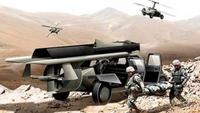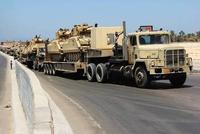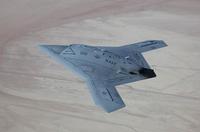-
Israel offers proof of Assad regime’s responsibility for chemical weapons attack
Israeli sources said that the IDF’s sigint unit, Unit 8200 – which, among other intelligence operations, routinely eavesdrops on communications among military and political leaders in Syria — has recordings of senior Syrian political and military officials discussing the timing and scope of the chemical attack last Wednesday against civilians in rebel-held areas. Israeli intelligence sources have also identified the Syrian military unit which fired the chemical weapons: the 155th Brigade of the 4th Armored Division of the Syrian Army, a division under the command of the Syrian president’s brother, Maher Assad.
-
-
A flying car is developed for the U.S. military

Flying cars would enhance the mobility of soldiers. Transportation will no longer be restricted to trafficable terrain that makes movement predictable and easy to track, and a flying car will enhance capabilities for resupply operations, fire-team insertion and extraction, and medical evacuation — reducing timelines and increasing the probability of survival.
-
-
As many as 1,400 killed in a suspected chemical attack in Syria (updated)
Rebel sources say the number of dead in a Syrian army chemical weapons attack, which targeted a dozen villages in a rebel-held area east of Damascus, has reached 1,400. The Syrian government admitted launching a major military offensive against rebels in the area – both rebels and government sources say it is the largest military operation since the beginning of the war — but strongly rejected the allegations about chemical weapons use by the Syrian army. The Israeli defense minister, in the first official Israeli reaction, confirms the Syrian military used chemical weapons. Chemical weapons experts say there are two other possibilities: the Syrian regime may have used crowd-dispersal chemicals in higher-than-usual concentration, causing death among people trapped in bunkers and shelters; or the army may have used fuel-air bombs in bombing Sunny residential areas. Such bombs, also called thermobaric explosives, rely on oxygen from the surrounding air, unlike most conventional explosives which consist of a fuel-oxidizer premix.
-
-
Secure, private Internet and cloud to soldiers, marines at the tactical edge
Squads of soldiers or marines on patrol in remote forward locations often do not have the luxury of quickly sharing current intelligence information and imagery on their mobile devices, because they cannot access a central server. Troops frequently have to wait until they are back at camp to download the latest updates. In the meantime, mission opportunities may erode because the information needed at the tactical edge isn’t immediately available. DARPA’s Content-Based Mobile Edge Networking (CBMEN) program aims to provide an alternative approach to the top down focus of most military networks by starting the content sharing at the individual soldier or marine level.
-
-
Conflicting readings of possible chemical weapons use in Syria
Rebel sources say the number of dead in a Syrian army chemical weapons attack, which targeted a dozen villages in a rebel-held area east of Damascus, is between 750 and 1,300. They say it is not possible to offer precise numbers because some areas are not yet accessible. The Syrian government strongly rejected the allegations about chemical weapons use by the Syrian army. The Israeli defense minister, in the first official Israeli reaction, confirms the Syrian military used chemical weapons. Chemical weapons experts say there are two other possibilities: the Syrian regime may have used crowd-dispersal chemicals in higher-than-usual concentration, causing death among people trapped in bunkers and shelters; or the army may have used fuel-air bombs in bombing Sunny residential areas. Such bombs, also called thermobaric explosives, rely on oxygen from the surrounding air, unlike most conventional explosives which consist of a fuel-oxidizer premix.
-
-
Reports: hundreds killed in chemical weapons attack east of Damascus
Syrian rebels say at least 750 people were killed in attacks on villages in rebel-held areas in the Ghouta region east of Damascus. News agencies quote medical personnel who confirmed that hundreds of victims treated in hospitals and make-shift first-aid stations were suffering from symptoms associated with chemical weapons attack. Syrian government officials deny that regime forces used chemical weapons. The Arab League called for immediate investigation, and the U.K. said it would bring the reports to the UN Security Council today.
-
-
Gen. Dempsey: U.S. military options against Iran “better” than last year
General Martin Dempsey, the chairman of the Joint Chiefs of Staff who is on an official visit to Israel and Jordan this week, said that in his meeting with Israeli leaders he told them that “since I was here last year [October 2012], [the United States has] better military options than we did a year ago” to deal with Iran’s nuclear weapons program. “That’s because we’ve continued to refine them,” he said. “We’ve continued to develop technology, we’ve continued to train and plan.”
-
-
New camouflage makeup shields soldiers, firefighters from heat of bomb blasts, fire
Camouflage face makeup for warfare is undergoing one of the most fundamental changes in thousands of years, as scientists today described a new face paint that both hides soldiers from the enemy and shields their faces from the searing heat of bomb blasts. Firefighters also could benefit from the new heat-resistant makeup.
-
-
Top 6 hottest new weapons
Competition spurs innovation and there is nothing more competitive than countries battling in the trenches of war. With billions upon billions in defense budget to spend, research into developing the best and most efficient weapons is on the forefront of investment.
-
-
Teams compete in challenging robotic helicopter competition

A U Michigan student team took part in an autonomous aerial vehicle competition. Their task: build a 3-pound flying machine that can, under its own control, take off, fly through a window into a model building, avoid security lasers, navigate the halls, recognize signs, enter the correct room, find a flash drive in a box on a desk, pick it up, leave a decoy, exit, and land in under ten minutes. Beyond military uses, autonomous vehicle they built could one day be used to survey collapsed buildings or inspect hard-to-get-to parts of bridges and other infrastructure. An offshoot group from a previous U-M team is working to commercialize the U-M technology through a startup called SkySpecs, which inspects windmills.
-
-
Israel, Egypt escalate attacks on militants in Sinai Peninsula (updated)

The growing intelligence cooperation between Egypt and Israel was in evidence early Friday when the Israel Air Force (IAF), in coordination with the Egyptian military, used drone strikes to destroy ready-to-launch rockets and rocket launchers on Egyptian territory, killing five Egyptian militants in the process. The rockets were deployed on Thursday in a desert area near the town of Rafah, and were discovered by an Egyptian surveillance fly-over. On Saturday, the Egyptian air force attacked militant positions in the area, killing twelve Islamists.
-
-
Deteriorating Sinai Peninsula security situation poses problems for Israel, Egypt

The attacks on Islamist targets in northern Sinai — by Israel on Friday and by Egypt on Saturday — are but the latest evidence of a growing problem of militancy and terrorism in the Sinai Peninsula, a vast, hard-to-control, lightly populated area consisting of steep mountain ranges and a forbidding desert. The growing al Qaeda presence in the area, the continuing influence of Iranian arms smuggling networks, and the influx of foreign Jihadists make the deteriorating security situation in the peninsula a threat both to Israel and to Egypt. The stipulations of the 1982 Egypt-Israel peace treaty complicate to fight against the militants.
-
-
Israeli drone strike, in coordination with Egypt, destroys militants’ rockets deployed on Egyptian territory
The growing intelligence cooperation between Egypt and Israel was in evidence earlier today (Friday) when the Israel Air Force (IAF), in coordination with the Egyptian military, used drone strikes to destroy ready-to-launch rockets and rocket launchers on Egyptian territory, killing five Egyptian militants in the process. The rockets were deployed on Thursday in a desert area near the town of Rafah, and were discovered by an Egyptian surveillance fly-over.
-
-
Obama administration renews drone campaign in Yemen
Responding to intelligence information about planned terrorist attacks by Al Qaeda in the Arabian Peninsula (AQAP), information which led to the closure of twenty-two U.S. embassies in the Middle East and North Africa and a travel warning issued by the Department of State, the Obama administration has launched a series of drone strikes in Yemen over the past ten days.
-
-
Navy uses drones for help with radar, communications

Scientists recently launched unmanned aerial vehicles (UAVs) from a research vessel in a significant experiment that could help boost the U.S. Navy’s radar and communications performance at sea.
Sailing off Virginia Beach, Virginia, from 13 to 18 July, the Office of Naval Research’s (ONR) Research Vessel (R/V) Knorr explored ocean and atmospheric weather variations that can change the angle that radar and radio waves bend, making it more difficult for ships to remain undetected and hindering their ability to communicate or locate adversaries.
-
More headlines
The long view
Tantalizing Method to Study Cyberdeterrence
Tantalus is unlike most war games because it is experimental instead of experiential — the immersive game differs by overlapping scientific rigor and quantitative assessment methods with the experimental sciences, and experimental war gaming provides insightful data for real-world cyberattacks.
Testing Cutting-Edge Counter-Drone Technology
Drones have many positive applications, bad actors can use them for nefarious purposes. Two recent field demonstrations brought government, academia, and industry together to evaluate innovative counter-unmanned aircraft systems.
European Arms Imports Nearly Double, U.S. and French Exports Rise, and Russian Exports Fall Sharply
States in Europe almost doubled their imports of major arms (+94 per cent) between 2014–18 and 2019–23. The United States increased its arms exports by 17 per cent between 2014–18 and 2019–23, while Russia’s arms exports halved. Russia was for the first time the third largest arms exporter, falling just behind France.
How Climate Change Will Affect Conflict and U.S. Military Operations
“People talk about climate change as a threat multiplier,” said Karen Sudkamp, an associate director of the Infrastructure, Immigration, and Security Operations Program within the RAND Homeland Security Research Division. “But at what point do we need to start talking about the threat multiplier actually becoming a significant threat all its own?”
The Tech Apocalypse Panic is Driven by AI Boosters, Military Tacticians, and Movies
From popular films like a War Games or The Terminator to a U.S. State Department-commissioned report on the security risk of weaponized AI, there has been a tremendous amount of hand wringing and nervousness about how so-called artificial intelligence might end up destroying the world. There is one easy way to avoid a lot of this and prevent a self-inflicted doomsday: don’t give computers the capability to launch devastating weapons.
